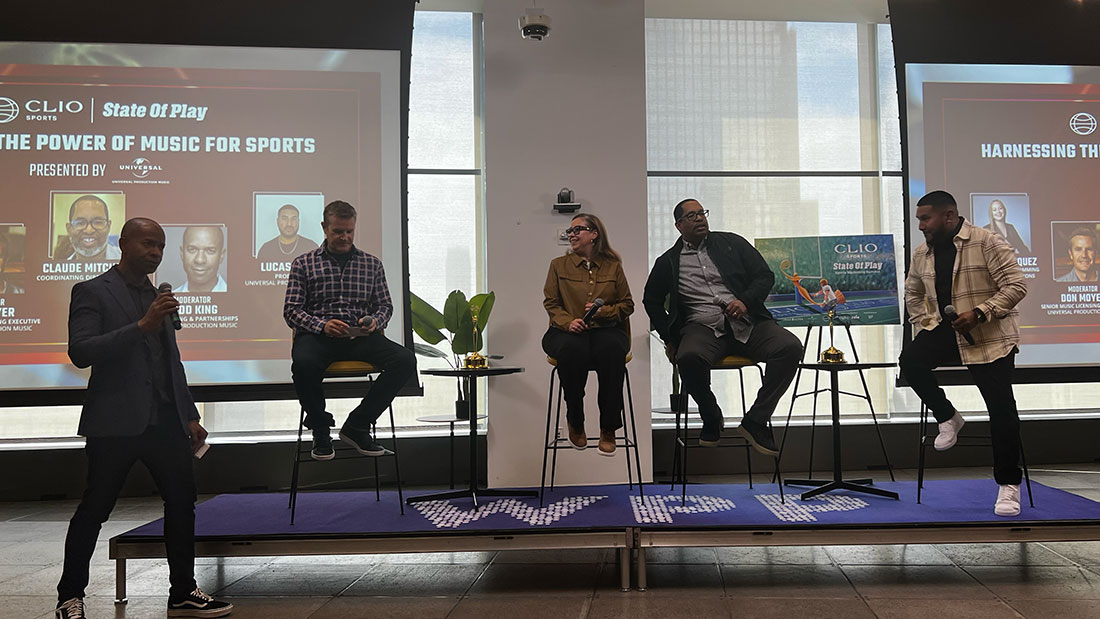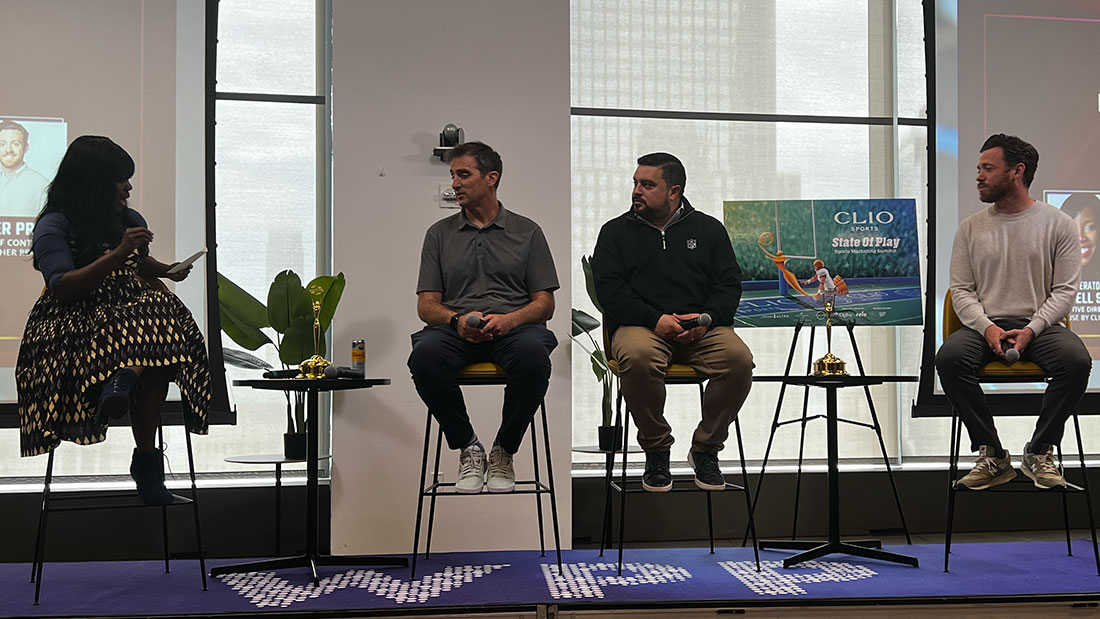Clio Sports State of Play: Nissan, ESPN, the NBA and Universal Music Explore Evolving Strategies
Big brands open their playbooks
For the second annual State of Play: Clio Sports Marketing Summit, a series of panels tackled front-of-mind topics like the power of music in sports marketing, reaching viewers via college athletics and the rise of alternative broadcasts.
Below, we look at the highlights from Monday’s event in NYC.
Harnessing the power of music for sports
The event kicked off with execs from Universal Production Music, ESPN and the NBA describing how music amplifies emotions across audio, video and static imagery.
For Claude Mitchell, coordinating director of music at ESPN, soundtracks are “the inspiration, the motivation and the direction that takes you through things.” Growing up a Yankees fan, Mitchell recalled that Frank Sinatra’s version of “New York, New York” was played at the end of a game they won, while Liza Minelli’s take closed out contests lost. In both cases, music heightens the experience.
Every song has a purpose. Lucas Spry, music director and producer at UPM, noted that “we’re not just throwing upbeat hip-hop tracks on an album just because we can. There’s purpose in that and the BPM tempo arrangement” can help define a collection of tracks.
The NBA recognizes how vital music and tempo are, too. Watching a LeBron James video on mute wouldn’t evoke as much energy and drive as watching with the sound turned up high.
“Music is a critical part of how we translate moments to our fans that are not only in attendance, but who are also engaging with us across our platforms,” said Jasmin Marquez, who helms music programming and business operations at the league.
“Tracks must resonate with all of our fans, no matter where you sit—whether it’s in the arena, or watching the broadcast, or catching it on our social media platforms.”
The music must amplify what’s happening on court, and enhance “how our fans, our teams, our players are all interacting with those moments,” he said.
Sometimes, picking local faves and melding them with global hits can prove a sound strategy.
“Everyone can source authentic regional music,” Spry said. “My job is to listen to that and find … how we can meld genres which work for every medium—social media or broadcast. There’s different tempos, there’s different moods, there’s different lyrical terms that really can make or break” a telecast or livestream.
College sports marketing success for Nissan
Nissan’s Director of U.S. brand & retail media, Rob Martin, spoke to Muse executive director Charell Star about going all in on college sports. That strategy’s driven impressive results, without the steep cost of, say, an NFL partnership.
The carmaker is the official partner of the Heisman Trust, an official NCAA corporate partner, and has multimedia rights agreements with universities across the country.
“You couldn’t just have the Heisman Trust. You couldn’t just have NCAA, although people do take that approach,” Martin said. “We needed a three-legged stool: the Heisman Trust, the NCAA, and the colleges and universities that we participate with. “By using all of those pieces of the puzzle, we can build a really cohesive, creative execution. You’re using colleges and IP, so it feels very authentic. It’s contextually relevant, and that’s why we built our strategy the way that we have.”
The Heisman House campaign, around since 2006, continues to evolve and elevate both creative and the Nissan brand.
“More than a into decade of a campaign, you better continue to think of new ideas. So what did we do? We launched the Heisman House on Zillow,” says Martin.
“Everybody’s looked at Zillow, looked at apartments, looked at houses,” he said. “Never did we think that we would put the Heisman House on Zillow. As you can imagine, everybody asks, ‘Is the house real?’ So we continue to fuel the idea. Yes, this is a real thing. An example of just how we continue to expand the platform and how we continue to refresh it with new ideas.”
Heisman House is the brand’s top performing promotional vehicle each year.
“When we talk about building brand awareness and building brand consideration, it’s our single most important property. So for us, that tells us not only is it about the media, but also just how we’re speaking to the audience. And we find year after year that we continue to see that brand awareness continue to happen, which is staggering when you think of how long this campaign has gone on. And frankly, that’s why we keep doing it.”
The rise of alternative broadcasts
Competing with second-screen viewers has become a challenge that alternative broadcasts aim to win. Execs from Bleacher Report, ESPN and the NFL explained exactly what alternative broadcasts are—and how they’re leaning into the practice.
“When we think about ESPN alternative broadcasts, we really think about creating complementary programs that are going to help to magnify or amplify the main broadcast, like our Toy Story animated football game,” said Tim Reed, the network’s VP of programming and acquisition. “The target there was younger audiences, and to drive co-viewing and distribute that across Disney+. It was a success because parents and kids really enjoyed it. I think the expectation is if we did more of that, they’d watch more.”
Tyler Price, VP of content, Bleacher Report, said: “We’re a digital-first entity that has made its mark by concentrating on the audience. That’s how we look at alternative broadcasts: What value can we provide, specifically in in terms of options and interactivity? How do we make our users feel they have power over what their options looks like?”
When done right, such alternatives are something the players themselves can get behind—with enviable numbers pointing to success.
“The Toy Story execution, the players and coaches, they were actually all, generally welcoming about this,” said Reed. “It showed an authentic side. We actually had some of the players bring their kids and their families into the actual vignettes or personality pieces and just integrate things they liked about Toy Story, their favorite characters.”
“Parents were likely to share that type of experience. And 90+ percent of kids were willing to watch another execution like that.”









